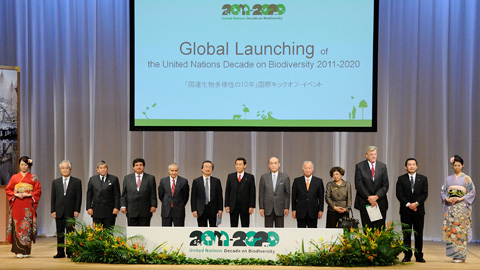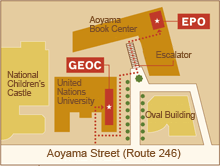
The vision of a future of life in harmony with nature is possible if the world takes action now. The United Nations Decade on Biodiversity (UNDB) was launched in Kanazawa, Japan, on 17 December 2011, in a commemorative ceremony organized by the United Nations University, in collaboration with the Ministry of the Environment of Japan, Ishikawa Prefecture, Kanazawa City and the Secretariat of the Convention on Biological Diversity (CBD).
The global launch of the United Nations Decade on Biodiversity counted on the participation of United Nations agencies, Parties to the CBD, and representatives of all levels of government in Japan. The three-day event also included a workshop on national biodiversity strategies and action plans (NBSAPs), a commemorative forum and excursions. The idea of declaring 2011-2020 the United Nations Decade on Biodiversity was initiated by Japan and endorsed at the tenth meeting of the Conference of the Parties (COP), held in Nagoya, Japan, in October 2010. It was then formally proclaimed by the United Nations General Assembly at its sixty-fifth session. The United Nations Decade on Biodiversity builds on the achievements of the successful celebration of the 2010 International Year of Biodiversity. It aims at implementing the first Aichi Biodiversity Target of the Strategic Plan on Biodiversity 2011-2020, namely to ensure that by 2020 all the people of the world will be aware of biodiversity and its value.
The events opened with a commemorative ceremony with over 600 people in attendance, and contained speeches from various international organizations. In his message addressed to participants, delivered by Mr. Kiyotaka Akasaka, Under-Secretary-General, United Nations Department of Public Information, Mr. Ban Ki-moon, Secretary-General of the United Nations, called “on all the Parties to the Convention on Biological Diversity and to all the biodiversity related conventions, as well as all members of the United Nations system, the private sector, civil-society groups and individual citizens and consumers worldwide, to rally to the call of the United Nations Decade on Biodiversity.” In conclusion, he stated, “Let us work together to live in harmony with nature, let us preserve and wisely manage nature’s riches for prosperity today and for the future we want.”
Mr. Katsuhiko Yokomitsu, Senior Vice-Minister of the Environment in the Government of Japan, speaking on behalf of Mr. Goshi Hosono, Minister of Environment of Japan and current President of the Conference of the Parties to the Convention, said: “The intensive efforts of all participants enabled the Conference of the Parties to achieve substantial results at its tenth meeting, including the adoption of new global targets for biodiversity. Given the current status of biodiversity, it is incumbent upon us to endeavour continually and unfailingly to achieve the Aichi Biodiversity Targets. To pass on to our children the abundant natural blessings of this planet, we must harness the collective wisdom of humanity and begin and extend concerted efforts across the globe to create societies that exist in harmony with nature.”
Professor Kazuhiko Takeuchi, Vice-Rector of the United Nations University, representing Professor Konrad Osterwalder, Rector of the United Nations University, echoed his words: “It is not too late to prevent the further loss of biodiversity. The presence of the representatives gathered here today from national governments, United Nations organizations, NGOs, the private sector and the public demonstrates the resolve of the international community to find inclusive global solutions to address this complex problem. I further encourage you to translate these messages into concrete actions. It is my strong belief that we have at our disposal all that is necessary to ensuring that these discussions are supported with effective policies and initiatives.”
Mr. Masanori Tanimoto, Governor of Ishikawa Prefecture, said: “Biodiversity is a global issue but it is also very close to people living in each local area, so it is important for a local government to tackle this issue with the understanding of and in collaboration with local communities. For this reason, we have been making efforts to conserve biodiversity through conservation and sustainable use of satoyama and satoumi in collaboration with the UNU-IAS Operating Unit of Ishikawa/Kanazawa and Kanazawa University. We will enhance our efforts on this occasion, the starting year of the United Nations Decade on Biodiversity. I’m expecting a strong message will be conveyed to the world today from here, Ishikawa.”
Mr. Masaru Onishi, President of Japan Airlines (JAL), said: “The Aichi Biodiversity Targets to be achieved over the Decade require participation of all stakeholders. Companies can contribute to this issue in various ways according to their type of business. As an airline company we can, for example, work toward target 9 by preventing unintentional introduction of invasive alien species, target 1 by promoting public awareness, target 5 by monitoring and reporting forest fires and target 10 by sampling and monitoring air quality, and preventing global warming.”
“The next decade will be crucial for the future of our planet. Only with action at all levels will we be able to secure a future of life in harmony with nature,” said Ahmed Djoghlaf, Executive Secretary of the Convention on Biological Diversity, “Japan, as the motor force behind the declaration of this United Nations Decade, has demonstrated leadership and vision in support of sustainable development and, indeed, life on Earth.”
At the welcome reception, the “Ishikawa Declaration” which was drafted by the organization “Rio+20 and Biodiversity Japan”, was introduced to promote “living in harmony with nature”, the concept of the Aichi Targets, and concrete actions to achieve these targets in the international community on the occasion of Rio+20 in collaboration with other stakeholders.
The Ishikawa Declaration calls on the participants to the Rio+20 Summit, scheduled for June 2012, to give high priority to the biodiversity agenda and fully integrate the Aichi Biodiversity Targets as an integral part the Summit’s expected outcomes. The Ishikawa Declaration follows the official submission last month by the President of the Conference of the Parties of the Strategic Plan for Biodiversity 2011-2020 and its Aichi Biodiversity Targets to the head of the secretariat of Rio+20 for inclusion as part of the expected outcomes of the Summit.
On 18 December, the second day of the event, an all day international workshop on National Biodiversity Strategic Action Plans (NBSAPs) was held with over sixty participants from United Nations organizations, government officials, host countries of NBSAP regional workshops, the representative of the President of COP11, the Secretariat of the Convention of Biological Diversity (CBD), Bureau members of CBD/COP, Bureau members of the Subsidiary Body on Scientific, Technical and Technological Advice (SBSTTA), academics, NGOs, and the private sector in attendance. The three sessions consisted of presentations followed by discussions on the topics of: “Preparation and updating of NBSAPs in line with the Strategic Plan for Biodiversity 2011-2020”, “Effective Means for Mainstreaming NBSAPs” and “Enhancing International Cooperation on Biodiversity and the Satoyama Initiative”. A commemorative forum to raise awareness of and encourage participation in biodiversity was also held in the morning.
On 19 December, the final day of the event, excursions to various sites within Ishikawa Prefecture were held to provide examples of Japanese efforts for biodiversity conservation, sustainable usage of natural resources, green economy business models and traditional Japanese methods for living in harmony with nature such as satoyama and satoumi. Highlights of the excursions were the “Shiroyone Senmaida” Rice Terraces in Noto, which along with Sado this year were the first sites in Japan to be designated as a Globally Important Agricultural Heritage Site (GIAHS); the Ishikawa Zoo, which is one of four crested ibis breeding sites in Japan for this endangered species; and Kamoike, which is a wintering spot for waterfowl that has been registered under the Ramsar Convention.
During the three days of events, major recurring themes were recognition of developing diverse NBSAPs among countries and the need for cooperation, the integration of biodiversity into development policy that also take into account local communities’ needs and stimulate action at the local level, advancement of the understanding of the green economy, receiving engagement from all sectors, and spreading public awareness of this pressing issue. Since the next ten years will define the future state of biodiversity on earth, the next decade will be crucial to protect permanent loss of many species of life on earth. The time to act is now, and the protection of biodiversity can only be truly realized with the active participation of each and every one of us. The United Nations University will continue in our efforts of contributing to protect biodiversity though our various research and education activities.
You can download presentation slides from the UNU-ISP wesite.

















